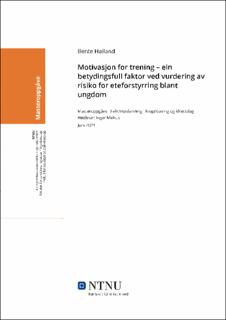| dc.contributor.advisor | Mehus, Ingar | |
| dc.contributor.author | Høiland, Bente | |
| dc.date.accessioned | 2021-09-28T17:34:42Z | |
| dc.date.available | 2021-09-28T17:34:42Z | |
| dc.date.issued | 2021 | |
| dc.identifier | no.ntnu:inspera:80187349:9097182 | |
| dc.identifier.uri | https://hdl.handle.net/11250/2784577 | |
| dc.description.abstract | Denne studien har som hensikt å undersøke samanhengen mellom ungdom sin motivasjon for trening og risiko for eteforstyrring, med eit teoretisk rammeverk beståande av to miniteoriar under sjølvbestemmingsteorien (SDT). For å vurdere motivasjon målast grad av tilfredsstilling og frustrasjon av behov, samt nærvere av autonome versus meir kontrollerte former for motivasjon uttrykt ved ulike motivasjonsreguleringar. Studien er utforma som elektronisk spørjeskjema med ei kvantitativ tilnærming, og er gjennomført blant totalt 337 ungdommar frå vidaregåande skular i Noreg. Det statistiske analyseprogrammet STATA blei nytta for behandling og analyse av datamaterialet, og presenterast og diskuterast med utgangspunkt i ein multippel hierarkisk lineær regresjonsmodell.
Resultata viser at frustrasjon av grunnleggande behov og kontrollerte former for ytre motivasjon (ytre- og innlemma regulering) bidreg signifikant til auke i risiko for eteforstyrring. Det blei identifisert ein signifikant konveks kurvelineær samanheng mellom tilfredsstilling av behov og risiko for eteforstyrring, der effekten av auka tilfredsstilling er sterkast for låge verdiar av tilfredsstilling. Meir autonome former for motivasjon viser å ikkje bidra signifikant til endring i risikovariabelen. Samla er hovudfunna frå studien at låg grad av sjølvbestemt motivasjon, uttrykt ved frustrasjon av grunnleggande behov og kontrollerte former for motivasjon, koplast til høgare risiko for eteforstyrring, medan høgare grad av sjølvbestemt motivasjon, uttrykt ved tilfredsstilling av behov, koplast til redusert risiko. Vidare blei kjønn og BMI identifiserte som signifikante kontrollvariablar, som på bakgrunn av eit signifikant samspelsledd må sjåast i samanheng. Spesifikt har jenter høgare risiko for å utvikle eteforstyrring, og kjønnseffekten aukar for høgare verdiar av BMI.
Funna tyder på at grad av sjølvbestemt motivasjon for trening er relevant å undersøke i samanheng med risiko for eteforstyrring blant ungdom. Resultata er i tråd med funn frå tidlegare forsking som viser at det først og fremst er den underliggande motivasjonen for trening, og ikkje kjenneteikn ved treningsdeltaking i seg sjølv, som er avgjerande for risikoen for å utvikle forstyrra eteåtferd. Studien vil forhåpentlegvis bidra til å auke bevisstheita kring tematikken og gjere at menneske som omgås ungdom innanfor treningskonteksten blir meir bevisste på korleis dei kan bidra til å redusere risiko for eteforstyrring blant ungdommane. | |
| dc.description.abstract | The purpose of this study is to examine the association between adolescents’ motivation for exercise and risk of developing an eating disorder, using two sub-theories of Self-Determination Theory (SDT) as theoretical framework. To assess motivation, the degree of satisfaction and frustration of basic psychological needs is measured, as well as regulatory styles of motivation representing autonomous and more controlled motivation for exercise. The study is designed as an electronic questionnaire with a quantitative approach, conducted among a total of 337 adolescents from upper secondary schools in Norway. The statistical analysis program STATA was used for processing and analysing the data material and is presented and discussed on the basis of a multiple hierarchical linear regression model.
Further, a significant convex curve-linear relationship between satisfaction of basic needs and risk of eating disorders was identified, where the effect of increased satisfaction is strongest for lower values of satisfaction. More autonomous forms of motivation showed not to contribute significantly to a change in the risk of eating disorders. In summary, the main findings of the study shows that lower degree of self-determined motivation, expressed by frustration of basic needs and more controlled forms of motivation, is associated with higher risk of developing an eating disorder, while a higher degree of self-determined motivation, expressed by satisfaction of basic needs, is associated with lower risk. Further, control variables gender and BMI significantly contributed to explaining variations in the risk of eating disorders. A significant interaction term indicates that the effect of gender varies for different values of BMI. Specifically, being girl is associated with higher risk, and the effect of gender increases with higher values of BMI.
The findings suggest that the degree of self-determined motivation for exercise is a significant factor of matter related to the risk of eating disorders among adolescents. The results support findings from previous studies showing that it’s first and foremost the underlying motivation for exercise, not characteristics of exercise participation per se, that are decisive for one’s risk of developing disturbed eating behaviour. Hopefully, the study will contribute to raise awareness about these topics and the associations between them, and specifically make people involved with adolescents within the context of exercise and eating particularly aware of how they can help reducing the risk of eating disorders. | |
| dc.language | nno | |
| dc.publisher | NTNU | |
| dc.title | Motivasjon for trening – ein betydingsfull faktor ved vurdering av risiko for eteforstyrring blant ungdom | |
| dc.type | Master thesis | |
